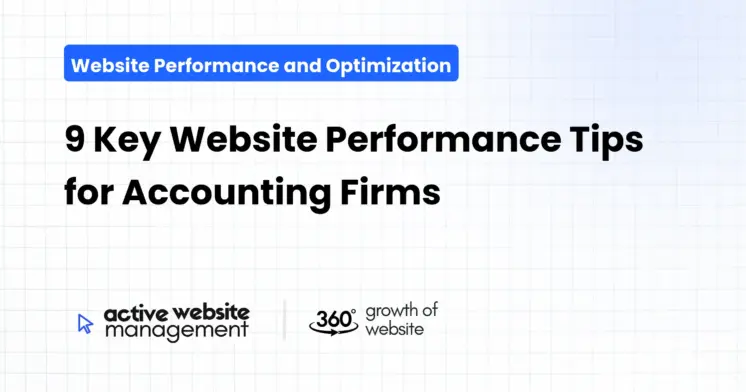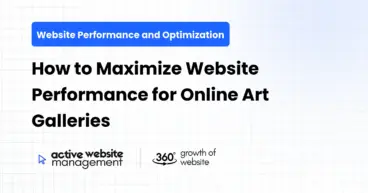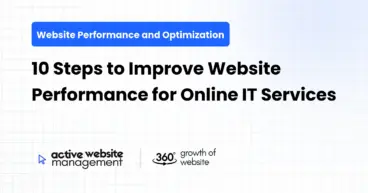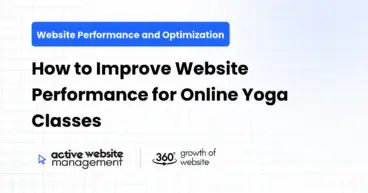February 4, 2025
14 min read
1. Diagnose & Conquer: Understanding the “Why” Behind Accounting Site Speed
Let’s face it: in the fast-paced digital world, a sluggish website is a deal-breaker. For accounting firms, this is especially critical. Your website isn’t just a brochure; it’s often the first impression you make on potential clients. A slow site screams “unreliable,” “outdated,” and even, dare we say, “incompetent.” You absolutely must optimize for CPA website performance.
1.1 The Ripple Effect of Slow Accounting Site Speed
Before diving into solutions, grasp the severity of the problem:
- Lost Leads & Revenue: Potential clients bounce before even seeing your services. Every second delay impacts your conversion rates and hurts your bottom line. A potential client landing on your site wanting financial service optimization is a lost opportunity.
- Damaged Brand Reputation: People associate website speed with trustworthiness. A slow site reflects poorly on your firm’s professionalism and attention to detail. A slow site communicates that you may not understand technology.
- Lower Search Engine Rankings: Google prioritizes user experience, and speed is a major factor. A slow site gets buried, making it harder for clients to find you. If you want to grow your firm, you must optimize your site.
- Increased Bounce Rate: People leave your site quickly out of frustration, increasing your bounce rate, and signaling to search engines that your site isn’t relevant.
- Decreased Engagement: Visitors spend less time on your site, leading to fewer inquiries, fewer downloads, and overall less engagement with your content.
1.2 Identifying the Culprits: What’s Slowing You Down?
To fix the problem, you need to understand the root causes. Common culprits include:
- Large, Unoptimized Images: High-resolution images eat up bandwidth and slow down loading times. Images should be optimized for the web.
- Bulky Code (HTML, CSS, JavaScript): Unnecessary or poorly written code bloats your website and slows rendering.
- Excessive HTTP Requests: Each element on your page (images, scripts, stylesheets) requires a separate request. Too many requests add up.
- Slow Hosting Server: A low-quality hosting provider can’t handle the traffic and resources your website needs.
- Lack of Caching: Caching stores static files so they don’t have to be re-downloaded every time a user visits your site.
- Too Many Plugins (especially in WordPress): Each plugin adds code and can potentially slow down your site.
- Outdated CMS (Content Management System) and Plugins: Outdated software often contains inefficiencies and security vulnerabilities.
- Poor Mobile Optimization: A site that isn’t optimized for mobile devices will load slowly on phones and tablets.
- No Content Delivery Network (CDN): A CDN distributes your website’s content across multiple servers, so users get data from the server closest to them.
1.3 Tools to Diagnose Your Accounting Site Speed Woes
Before implementing any changes, measure your current website speed. Several free and paid tools can help:
- Google PageSpeed Insights: A free tool that analyzes your website’s speed and provides actionable recommendations.
- GTmetrix: Another popular tool that offers detailed insights into your website’s performance.
- Pingdom Website Speed Test: A user-friendly tool that tests your website’s speed from different locations.
- WebPageTest: A more advanced tool that provides in-depth performance analysis.
Use these tools regularly (at least monthly) to track your progress and identify new issues as they arise.
Don’t Just Maintain Your Website—
Grow It using Active Website Management! Don't Wait for Growth—Accelerate It with Active Website Management
2. Image Optimization: Turning Visuals into Speed Boosters
Images are essential for visually engaging your audience, but they can also be a major drag on your website’s performance. Optimizing your images is a crucial step for CPA website performance. Don’t let beautiful visuals kill your speed.
2.1 The Optimization Trifecta: Size, Format, and Compression
- Size: Resize images to the exact dimensions they will be displayed on your website. Don’t upload a 3000×2000 pixel image if it’s only going to be displayed at 600×400 pixels.
- Format: Use the right image format for the job:
- JPEG: Best for photographs and images with lots of colors.
- PNG: Best for images with sharp lines, text, and transparency (like logos).
- WebP: A modern image format that offers superior compression and quality compared to JPEG and PNG (but may not be supported by all browsers).
- Compression: Reduce the file size of your images without sacrificing too much quality. Use image compression tools (see below).
2.2 Image Optimization Tools: Your Arsenal for Speed
Several excellent tools can help you optimize your images:
- TinyPNG/TinyJPG: Free online tools that use intelligent lossy compression techniques to reduce the file size of PNG and JPEG images.
- ImageOptim (Mac): A free, open-source tool that optimizes images by removing unnecessary metadata and applying lossless compression.
- ShortPixel: A WordPress plugin that automatically optimizes images as you upload them.
- Imagify: Another popular WordPress plugin that offers various compression options and features.
- Adobe Photoshop: A professional image editing software with powerful optimization features.
2.3 Best Practices for Image Optimization
- Use Descriptive File Names: Instead of “image1.jpg,” use “accounting-firm-tax-services.jpg.” This helps with SEO.
- Add Alt Text: Alt text describes the image to search engines and screen readers. Use relevant keywords in your alt text.
- Lazy Loading: Load images only when they are visible in the user’s viewport. This significantly improves initial page load time.
- Consider using SVGs: For logos and simple graphics, SVGs (Scalable Vector Graphics) are often a better choice than raster images (JPEG, PNG) because they are smaller in file size and scale without losing quality.
3. Code Optimization: Streamlining Your Website’s DNA
Clean, efficient code is essential for a fast website. Bulky, poorly written code slows down rendering and hurts performance. This is a key component of financial service optimization.
3.1 Minification: Removing the Unnecessary
Minification involves removing unnecessary characters (whitespace, comments, etc.) from your HTML, CSS, and JavaScript files. This reduces file size without affecting functionality.
- HTML Minification: Removes unnecessary tags and attributes.
- CSS Minification: Removes whitespace, comments, and redundant CSS rules.
- JavaScript Minification: Removes whitespace, comments, and shortens variable names.
3.2 Bundling: Combining Files for Efficiency
Bundling combines multiple CSS and JavaScript files into fewer files. This reduces the number of HTTP requests, which significantly improves page load time.
3.3 Tools for Code Optimization
- Online Minifiers: Several online tools can minify your code, such as:
- Minifycode.com
- Toptal CSS Minifier
- UglifyJS (for JavaScript)
- WordPress Plugins: If you’re using WordPress, plugins like Autoptimize and W3 Total Cache can automatically minify and bundle your code.
- Build Tools: For more complex websites, consider using build tools like Webpack or Gulp to automate code optimization.
3.4 Best Practices for Code Optimization
- Keep Your Code Clean and Organized: Use proper indentation and comments to make your code easier to read and maintain.
- Avoid Inline CSS and JavaScript: Place CSS in external stylesheets and JavaScript in external scripts. This allows for caching and reduces code duplication.
- Use a CSS Preprocessor (Sass or Less): CSS preprocessors make it easier to write and maintain CSS code.
- Validate Your Code: Use online validators to check your HTML, CSS, and JavaScript code for errors.
Don't Wait for Growth—Accelerate It with
Active Website Management Don't Wait for Growth—Accelerate It with Active Website Management
4. Caching Strategies: Serving Content at Lightning Speed
Caching is a technique that stores static files (images, CSS, JavaScript) so they don’t have to be re-downloaded every time a user visits your site. This significantly improves page load time and reduces server load.
4.1 Types of Caching
- Browser Caching: Instructs the user’s browser to store static files locally. This is the most basic form of caching.
- Server-Side Caching: Stores static files on the server. This reduces the load on the database and improves response time.
- Content Delivery Network (CDN) Caching: Stores static files on a network of servers around the world. This ensures that users get data from the server closest to them.
4.2 Implementing Caching
- Browser Caching: Configure your web server to send appropriate HTTP headers that instruct browsers to cache static files. The
Cache-Control and Expires headers are commonly used for this purpose. - Server-Side Caching: Use a server-side caching mechanism like Memcached or Redis.
- CDN Caching: Sign up for a CDN service like Cloudflare, Amazon CloudFront, or Akamai. Configure your website to use the CDN.
4.3 WordPress Caching Plugins
If you’re using WordPress, several plugins can help you implement caching:
- W3 Total Cache: A comprehensive caching plugin that supports various caching methods, including browser caching, server-side caching, and CDN integration.
- WP Super Cache: A simpler caching plugin that creates static HTML files from your dynamic WordPress pages.
- LiteSpeed Cache: A powerful caching plugin specifically designed for LiteSpeed web servers.
4.4 Best Practices for Caching
- Cache Static Files Aggressively: Set long cache expiration times for static files that don’t change frequently (images, CSS, JavaScript).
- Use a CDN: A CDN is essential for serving content to users around the world.
- Test Your Caching Configuration: Make sure your caching is working correctly by using browser developer tools or online caching testers.
- Clear Your Cache Regularly: Clear your cache after making changes to your website’s content or code.
5. Database Optimization: The Backbone of Your Accounting Website
For dynamic websites (like those built with WordPress), the database is where your content is stored. A slow database can significantly impact your website’s performance.
5.1 Identifying Database Bottlenecks
- Slow Queries: Queries that take a long time to execute can slow down your entire website.
- Unoptimized Tables: Tables that are not properly indexed or structured can lead to slow queries.
- Bloated Database: A database that contains unnecessary data (revisions, spam comments, etc.) can become bloated and slow.
5.2 Optimizing Your Database
- Optimize Tables: Use the
OPTIMIZE TABLE command (in MySQL) to defragment and optimize your database tables. - Index Your Tables: Add indexes to your tables to speed up queries. Identify the columns that are frequently used in queries and add indexes to those columns.
- Remove Unnecessary Data: Delete revisions, spam comments, and other unnecessary data from your database.
- Limit Post Revisions: Limit the number of post revisions that WordPress stores. This can significantly reduce the size of your database.
- Use a Database Optimization Plugin: If you’re using WordPress, plugins like WP-Optimize and Advanced Database Cleaner can help you optimize your database.
5.3 Database Maintenance
- Regular Backups: Back up your database regularly in case of data loss.
- Monitor Performance: Monitor your database performance using tools like phpMyAdmin or MySQL Workbench.
- Consider a Managed Database Service: If you’re not comfortable managing your database yourself, consider using a managed database service like Amazon RDS or Google Cloud SQL.
6. Content Delivery Network (CDN): Global Reach, Local Speed
A CDN is a network of servers distributed around the world that stores your website’s static content (images, CSS, JavaScript). When a user visits your website, the CDN serves the content from the server closest to them, resulting in faster loading times.
6.1 Benefits of Using a CDN
- Faster Loading Times: Users get content from the server closest to them, reducing latency.
- Reduced Server Load: The CDN handles the delivery of static content, reducing the load on your web server.
- Improved Scalability: A CDN can handle spikes in traffic without affecting your website’s performance.
- Enhanced Security: Many CDNs offer security features like DDoS protection and web application firewalls.
6.2 Choosing a CDN
- Cloudflare: A popular CDN that offers a free plan and various paid plans with more features.
- Amazon CloudFront: A robust CDN from Amazon Web Services.
- Akamai: A leading CDN provider with a global network of servers.
- KeyCDN: A cost-effective CDN with a focus on performance.
6.3 Integrating a CDN
- Sign Up for a CDN Account: Choose a CDN provider and sign up for an account.
- Configure Your Website: Configure your website to use the CDN. This typically involves changing your DNS settings to point to the CDN’s servers.
- Test Your CDN Integration: Make sure your CDN is working correctly by using browser developer tools or online CDN testers.
7. Mobile Optimization: Catering to the On-the-Go Client
More and more people are accessing the internet on their mobile devices. Optimizing your website for mobile is crucial for providing a good user experience and improving your search engine rankings. The most important step to take for mobile optimization is ensuring your website is responsive. Responsive design is a web development approach that creates dynamic changes to the appearance of a website, depending on the screen size and orientation of the device being used to view it.
7.1 Mobile-First Indexing
Google now uses mobile-first indexing, which means that it primarily uses the mobile version of your website for indexing and ranking. If your website is not mobile-friendly, it will likely rank lower in search results.
7.2 Mobile Optimization Techniques
- Responsive Design: Use responsive design to ensure that your website adapts to different screen sizes.
- Optimize Images: Optimize images for mobile devices by reducing their file size.
- Use Mobile-Friendly Navigation: Use a simple and easy-to-use navigation menu that is optimized for mobile devices.
- Avoid Flash: Flash is not supported on many mobile devices. Use HTML5 instead.
- Test Your Website on Mobile Devices: Test your website on different mobile devices to make sure it looks and works correctly.
- Accelerated Mobile Pages (AMP): AMP is an open-source project that aims to improve the performance of mobile websites.
7.3 Tools for Mobile Optimization
- Google’s Mobile-Friendly Test: A free tool that tests your website’s mobile-friendliness.
- Responsive Design Checker: Online tools that allow you to view your website on different screen sizes.
8. Choosing the Right Hosting: The Foundation of Your Website’s Speed
Your hosting provider plays a critical role in your website’s performance. A slow or unreliable hosting provider can significantly impact your website’s speed and uptime.
8.1 Types of Hosting
- Shared Hosting: The most affordable type of hosting. Your website shares resources with other websites on the same server.
- VPS Hosting (Virtual Private Server): A virtualized server that provides more resources and control than shared hosting.
- Dedicated Hosting: An entire server dedicated to your website. This provides the most resources and control but is also the most expensive.
- Cloud Hosting: A scalable hosting solution that uses a network of servers.
- Managed WordPress Hosting: Hosting specifically designed for WordPress websites. This typically includes features like automatic updates, backups, and security enhancements.
8.2 Factors to Consider When Choosing a Hosting Provider
- Speed and Performance: Choose a hosting provider with fast servers and a reliable network.
- Uptime: Choose a hosting provider with a high uptime guarantee.
- Scalability: Choose a hosting provider that can scale your resources as your website grows.
- Security: Choose a hosting provider with robust security measures in place.
- Customer Support: Choose a hosting provider with responsive and helpful customer support.
- Price: Choose a hosting provider that fits your budget.
8.3 Recommended Hosting Providers
- SiteGround: A popular hosting provider known for its speed, security, and customer support.
- WP Engine: A managed WordPress hosting provider that offers excellent performance and security.
- Kinsta: Another managed WordPress hosting provider that is known for its speed and scalability.
- Cloudways: A cloud hosting platform that allows you to choose from multiple cloud providers (like AWS, Google Cloud, and DigitalOcean).
9. Active Website Management: Consistent Performance, Continuous Growth with Active Website Management
Website performance isn’t a one-time fix. It requires ongoing monitoring, maintenance, and optimization. This is where Active Website Management comes in.
9.1 Why Active Website Management Matters
- Performance Degradation Over Time: Websites tend to slow down over time due to factors like code bloat, outdated plugins, and increased traffic.
- Security Vulnerabilities: Websites are constantly under attack from hackers. Regular security updates and monitoring are essential to protect your website.
- Keeping Up with Technology: The web is constantly evolving. Active Website Management ensures that your website stays up-to-date with the latest technologies and best practices.
9.2 Active Website Management Services
Active Website Management offers comprehensive website management services, including:
- Performance Monitoring: Continuous monitoring of your website’s speed, uptime, and other key performance metrics.
- Security Updates and Monitoring: Regular security updates and monitoring to protect your website from hackers.
- Content Updates: Regular content updates to keep your website fresh and engaging.
- Plugin and Theme Updates: Regular plugin and theme updates to ensure compatibility and security.
- Backups: Regular backups of your website to protect against data loss.
- Technical Support: Responsive technical support to address any issues that may arise.
- SEO Optimization: Ongoing SEO optimization to improve your website’s search engine rankings.
- Website Audits: Regular website audits to identify performance issues and areas for improvement.
9.3 Benefits of Active Website Management with Active Website Management
- Improved Website Performance: Faster loading times, improved uptime, and a better user experience.
- Enhanced Security: Protection against hackers and other security threats.
- Increased Traffic: Improved search engine rankings and more organic traffic.
- Reduced Costs: Prevent costly downtime and security breaches.
- Peace of Mind: Knowing that your website is in good hands.
- Focus on Core Business: Allows you to focus on running your accounting firm, rather than worrying about website maintenance.
- Expert Guidance: Access to a team of website management experts.
- Proactive Problem Solving: Identifying and addressing potential problems before they impact your website.
- Consistent Brand Image: Ensuring your website consistently reflects your brand and values.
By implementing these 9 key website performance tips and investing in Active Website Management, accounting firms can create websites that are fast, secure, and effective at attracting and retaining clients. Remember, your website is a valuable asset. Treat it that way. Consistent financial service optimization is key for growth!







